 |
Click the small pictures throughout the review to view larger versions.

RS76635 - Resin Specialist AEC Regal IV 4RF4 Park Royal bodied British European Airport Coach sits on its individually numbered plinth
|
A Brief History
AEC Regal IV 4RF4 Airport Coach
The Airport RF came about following London Transport's gaining of the contract to operate coaches to London's three main passenger airports in 1947. British European Airways operated a Central London Terminal where passengers booked in and were then ferried along with their luggage to catch the flight at the respective Croydon, Northolt or Heathrow airports.
The contact for these services was originally operated with a fleet of BEA owned 18 seater deck & a half Commer Commandoe Coaches. As the popularity of air travel grow in the early 1950s the need for larger vehicles became apparent and thus London Transport persuaded BEA to purchase a fleet of 65 AEC Regal IV 4RFR4 deck & a half private hire coaches.
These new purpose built vehicles were based on the same AEC Regal IV 9822E chassis that had been used for London Transport's fleet of 15 RFW coaches. The Airport Coaches seated 37 passengers and featured a raised rear section with seating for 21, this allowed luggage to be stored in large locker area below the floor. It was claimed that this 250 cubic feet space could accommodate 100 full size suitcases. The Airport RFs as they became known, bore a strong styling resemblance to the standard London Transport Metro-Cammell bodied RF bus, even though they had a wider 8 foot Park Royal built bodies.
The Airport fleet received three different liveries during their working life on the BEA services, the vehicles were delivered during 1952/53 and arrived in a livery of light grey upper with dark grey panels below a white waistband.
Following vehicle overhauls in 1957/8 they received a revised livery which saw the light grey replaced by white, and the dark grey extended over the waistband and onto the panels below the raised rear windows. A third revision of the livery was introduced in the 1960s and this saw the dark grey replaced with dark blue and waistband once again highlighted but this time in black. This version appears to have only been applied to a small number of the fleet however.
The vehicles enjoyed a fairly long operating life, but by the mid 1960s the higher number of air passengers were fast overwhelming the capacity offered by the 4RF4s. London Transport once again persuaded BEA to purchase a new fleet of vehicles based on the then LT standard double deck Routemaster. The Airport RFs were thus replaced by 65 Front Entrance Routemasters and fleet of luggage trailers during 1966/7, however one RF MLL 740 was retained as a spare for the Routemasters and also gained a new livery of bright orange with white roof and upper deck window surrounds.
MLL 740 was finally retired from the BEA services in 1973 however four other vehicles withdrawn in 1967 had been retained by London Transport and converted into mobile uniform issuing units. They received the standard light grey service vehicle fleet livery and had their windows blanked out so they could be used as changing rooms. The vehicles were also equipped with trailers similar to those used by the Airport RMA Routemasters which contained the actual uniform stock. The four vehicles, 1465W (MLL 725), 1466W (MLL 726), 1467W (MLL 729) and 1468W (MLL 735) gave 9 more years service with the last pair finally being withdrawn in February 1977.
A more detailed history of the AEC 4RF4 vehicles can be found at Ian's Bus Stop.
| Vehicle File |
| Chassis | AEC Regal IV 4RF4, AEC model 9822E | Bodywork | Park Royal 37 Seats (16 front & 21 rear) RDP37C |
| Dimensions | Length: 30ft (9.14m), width: 8ft (2.43m) | Number Built | 65 |
| Fleet Numbers | None allocated | Registrations | MLL 713-762, NLP 636-650 |
Chassis
Numbers | 982E1175-1214/1485-1509 | Body Numbers | None allocated |
| Delivered | 1952/3 |
Withdrawn | 1966/7, (MLL 740) 1973, (1465-8W) 1976/7 |
| Liveries | (1) Light grey upper, Dark grey lower, white waistband & black mudguards.
(2) White upper, dark grey lower & waistband, black mudguards.
(3) Dark blue lower & white upper with black waistband & mudguards. (Selected number of vehicles only)
(4) Orange with white roof, upper window surrounds & large BEA fleet names (MLL 740 only)
(5) LT service vehicle light grey with black waistband (Uniform Issue Units 1465-8W) |
Operating
Garages | 1952-7 Victoria Basement (GM), 1957-60 Shepherds Bush (S), 1960-73 Hammersmith (HB)
Outstation: 1957-65 Reigate (RG) |
|
|


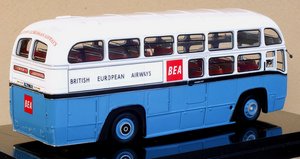
|
The Model
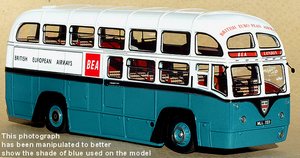
Before I start the review of this model I must point out that the shade of blue used on the model hasn't unfortunately been accurately recorded by my digital camera. It is in reality somewhat darker than shown in must of my photographs on this page, must importantly however it appears to be a good match to that used by BEA. The picture to the left has been photo-shopped to better reflect the correct shade. |
|
|
The range of resin model buses has grown substantially is the past couple of years, although these models are more expensive than the average diecast, they do have a much higher degree of detailing particularly in terms of the internal features.
The Jotus model reviewed is part of the companies Resin Specialist range and like previous models in this range is made up of a resin body and white metal baseplate. The baseplate gives the model a pleasingly heavy feel which adds a quality feel and a weight more akin to a diecast.
This is the first version of the AEC 4RF4 model released and comes decorated in the white & blue livery of British European Airways, this particular application dates back to the mid 1960s and was the last scheme worn by all but one of these distinctive vehicles. The vehicle modelled bears the registration MLL 723, these vehicles although operated by London Transport never carried any fleet numbers and were always referred to by their registrations.
The shape of the vehicle with it's generously curved roof domes & more subtle front & rear profiles has been captured to great effect. The window pillars all look well proportioned and unlike the earlier Jotus FRM 1 model, the thickness of the resin body shell isn't visible on the interior of the pillars themselves which gives a much improved overall appearance.
The exterior paint finish is very good and has a nice glossy finish, the application provides a very even colour depth and is thin enough not to overwhelm any of the finer detailing found on the bodyshell.
|
|
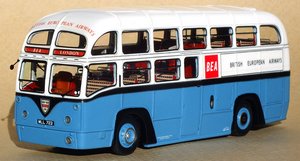
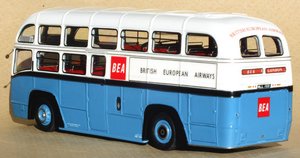
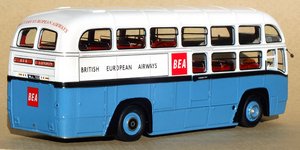
|
|
All the glazing is extremely clear & gives undistorted views of the interior. Black glazing bars have been neatly added to form the side window vents and the split in the drivers cab window.
Each window has a very delicate black surround which reproduces the rubber glazing gaskets used on these vehicles.
|
|
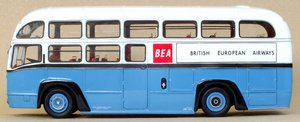

|
|
Two thin silver strips run around the model below the upper set of windows, these have a convincing chrome look and have been expertly applied all the way around the model.
The black mudguards are neatly painted and have clean edges where the meet the blue of the main body.
|
|
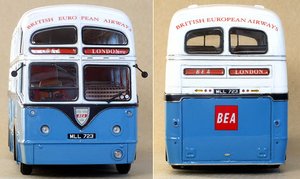
The model has glazed front & rear destination displays which like the windows have the thin black surrounds. The white on red displays themselves are slightly recessed behind the glazing which looks convincingly accurate. The model carries London destinations.
The front lights are all separate clear resin components, the lenses contain internal detailing for the bulbs and again they look very realistic as a result.
The tiny round red rear lights are also resin inserts while the arrow shaped direction indicators are represented with amber coloured inserts.
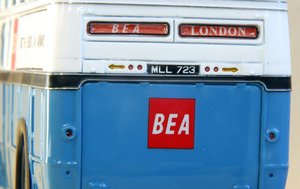 Further detailing on the rear sees a fine silver trim fitted to the lower edge of the rear body panels and a small chrome lock on the rear luggage compartment door.
Further detailing on the rear sees a fine silver trim fitted to the lower edge of the rear body panels and a small chrome lock on the rear luggage compartment door.
The model has delicate looking black driving mirrors which have very fine support arms and a silvered rear surface. Small black windscreen wipers are affixed to the front windows and the nearside window also has two tax disc holders positioned behind the glazing.
|
|
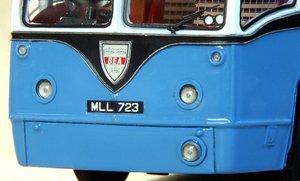

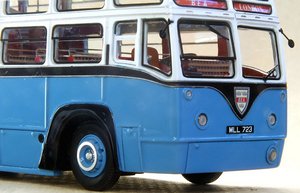
|
|
The roof has panel beading and two moulded air vents towards rear. Red "British European Airways" names follow the curved profile of the top edge of the windows on both the front and rear domes. Whether they should be there is however is open to debate. I've found a colour photograph, in the Capital Transport book "RF" by Ken Glazier, showing MLL 723 in the livery depicted and the vehicle doesn't have the fleet names on the front dome. As far as I can tell these were only a feature of the original two tone grey livery.
|
|

The roof has two air vents moulded towards the rear and there's corresponding interior detailing for these as well
|

The baseplate as mentioned earlier is cast white metal and has fair level of detailing which includes the chassis, exhaust pipe and a couple of tanks. There's no manufacturer branding or model description on the baseplate however and it is secured to the resin body with a single cross head screw. Removing the screw releases the base plate but the internal seating unit is securely glued in place and I suspect this would prevent any chance of its removal for those thinking about adding some passengers & a driver.
|
|
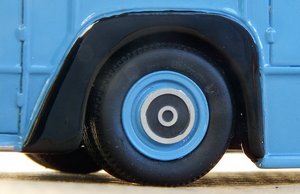 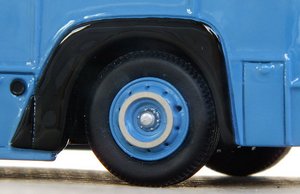
The wheel hubs have been nicely reproduced. The front ones have tiny holes in them as per the real vehicle and the central hub area has been accurately painted, a well defined silver nut ring completes the effect. The rear double wheels are depicted fitted with flat hub disc covers, these have black centers and two silver rings. Six rubber look tires are fitted and these include a fine trend pattern.
|
|
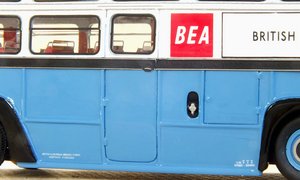
Moving to the sides of the model, both the nearside entrance door & off-side emergency door have separate door handle components. The silver filler cap on the nearside is also a separate component rather than a painted body feature.
The side indicator semaphore arms are modelled in the retracted position but again they have been applied as separate components and stand slightly proud of the main body.
The external decals all appear to be printed directly onto the body, however unlike diecast models were these would have a slightly raised appearance Jotus have achieved a completely smooth finish.
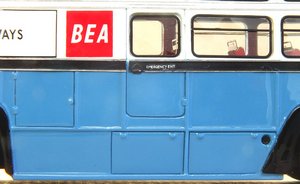
Compared with more modern vehicles the Airport RFs didn't have much in the way of exterior signs, there's an Emergency Exit one on the off-side door and some tiny legal lettering, unladen weight & top speed details on the nearside skirt panels. Despite the size, all of these they are fully legible.
The model has a thin metallic strip which wraps around the body to form the silver edged black waistband. At the front this incorporates a detailed badge which has three silver
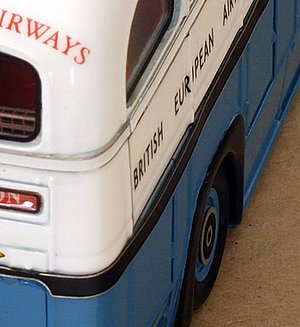 crowns & a red central bar bearing white BEA lettering.
crowns & a red central bar bearing white BEA lettering.
There's certainly no complaint about the actual finishing of waistband detailing, but the actual application of the band to the body does leave a little to be desired on the review model. Towards the rear on both sides there are tiny gaps visible behind the strip which results in slightly buckled appearance. The problem seems to stem from the fact the strip itself is glued in place over the raised vertical panel beading on the bodyshell.
|
|
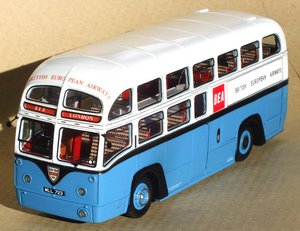
One thing that sets resin models apart from their diecast cousins is the level of attention paid to the interior, this model is a another good example of that.
The tops of most of seats have fine grab bars affixed while the seat cushions have the correct cream & black cloth motif reproduced. There are delicate chrome handrails and two vertical poles around staircase that leads up to the raised rear section.
The drivers area has a brown painted seat while the steering wheel & support column are both finished in black. There's also a silver topped black hand brake lever on the offside of the seat. Unlike the earlier Jotus Volvo Aslia V3 model no attempt has been made to reproduce any of the dials or switches on the dashboard.
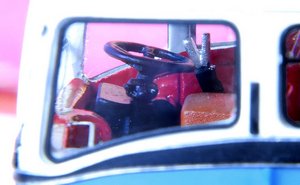
The interior of the body is mainly finished in white and the ceiling includes panel beading and a pair of air vents towards the rear which have been picked out in silver. The seating unit and body panels below the windows are mainly finished in the standard London Transport Indian Red although the floor has been painted brown.
Finally a word on the overhead luggage racks positioned above the seats in both the lower & upper sections of the model. These are finished in white but have inserts on the top to represent the mesh used on the real vehicles. They also have what I presume are tiny individually painted reading lights on the underside which to be honest would probably go unnoticed by most owners of the model unless a close examination was made with a magnifying glass.
|
|

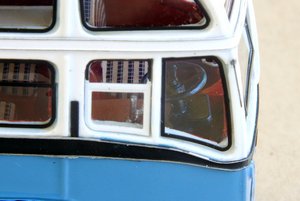
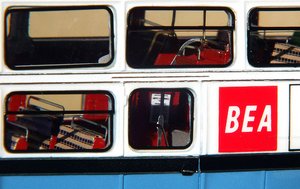

The interior detailing is extensive and includes luggage racks, grab rails, seat cushion motif and a number of signs
|

There are a number of decals applied to the interior of the model, the largest of these are positioned above the front windscreen and pair give the same notice in both English & French as illustrated. The text of both signs is actually perfectly legible although I doubt anyone would be able to read them with the naked eye.

Another even smaller sign is present on the front roof dome, it gives the seating capacity and includes some Dunlop advertising. Finally the most noticeable sign is the one positioned on the panel beside the staircase which tells boarding passengers about Airport Coach Service Tickets.
|
|
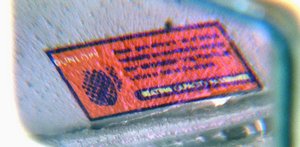
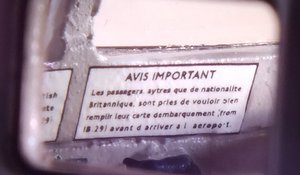
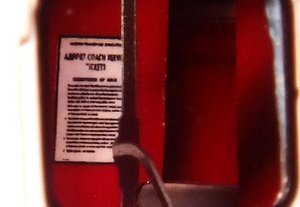
All the tiny signs hidden inside the model are reproduced to an extremely high standard.
|
|
The model comes in a plastic display case and is attached to the black plastic plinth with two cross head screws. The plinth also has a chrome finished plaque which is engraved with a description of the model, the BEA shield & the number of the individual model within the run of 500 produced.
The display case is in turn packaged in a sturdy black finished card presentation box which has labels bearing a description of the model on the ends of the lid.
|
|
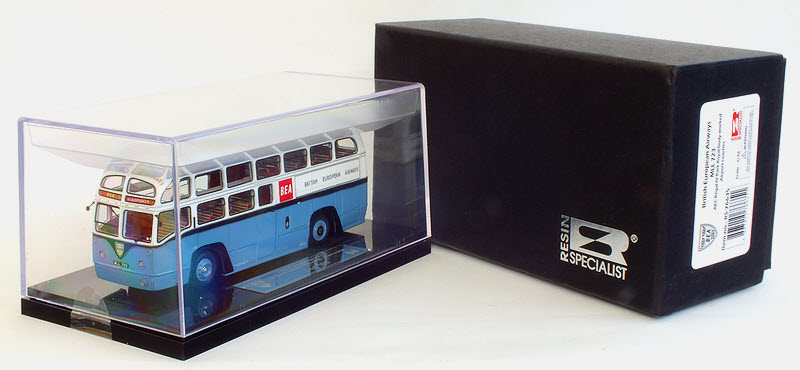
The model comes in a plastic display case which is in turn packaged in a black card box.
|
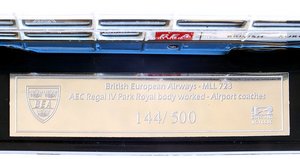
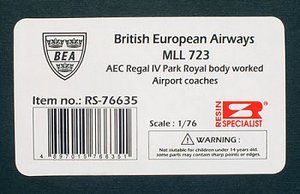
This model is a limited edition of 500 pieces and each is individually
numbered by way of an engraved metal plaque affixed to the display case plinth
|
|
Overall this is a excellent model and the craftsmanship displayed in its production is simply astonishing. The model retails in the UK for around £75.00 which certainly isn't cheap, but you do get a lot for your money and it seems unlikely that any diecast manufacturer would be willing to produce such a detailed model of a vehicle which only has scope for four possible livery options. The only fault I can level concerns the slightly poor application of the waistband strip but to be honest this isn't really that noticeable unless you look very closely at the model.
I understand this first version is expected to sale out and that a second version depicting the unique orange livery carried by MLL 740 is planned as a future release.
|
|
|
Pros:
- Captures the essence of this distinctive vehicle extremely well
- Very high level of exterior detailing
- Excellent interior detailing
- Good paint finish throughout
- Good packaging
Cons:
- Expensive compared to most diecast models
- Application of waistband trim isn't perfect
- Company names shouldn't be present on front & rear roof domes
Marks:
Construction: 9/10
Livery Application : 9/10
Decal Application: 9/10
Interior Detailing 10/10
Likeness to Subject: 10/10
Overall: 8.5/10
|
|
| Model Review Index |




































